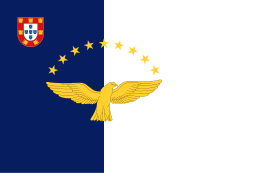Dollabarat
| Dollabarat | |
| Reef (Recife) | |
| Official name: Recife de Dollabarat | |
| Named for: Pierre Dollabarat, captain of who "discovered" the reef by accident on 7 March 1788 | |
| Country | |
|---|---|
| Autonomous region | |
| Islands | Eastern Group |
| Location | Azores Platform, Mid-Atlantic Ridge, Atlantic Ocean |
| Highest point | Dollabarat |
| - elevation | −3 m (−10 ft) |
| - coordinates | 37°13′28.96″N 24°44′26.83″W / 37.2247111°N 24.7407861°W |
| Area | 35.42 km2 (14 sq mi) |
| Biome | Marine (ocean) |
| Geology | Alkali basalt, Tephra, Trachyte, Trachybasalt |
| Orogeny | Volcanism |
| Period | Holocene |
The Dollabarat Reef is a shoal situated 5 km (3 nautical miles) south-southeast of the Formigas Islets, on the Formigas Bank in the Azores archipelago.
History
The origin of the name is from Pierre Dollabarats, the Basque captain of the ship Maria de Sebourre, who had the unlucky honour of discovering the reef as his small boat wrecked on it on 7 March 1788.
Geography
The Dollabarat Reef is part of the Formigas Islets Nature Reserve which covers 35.42 square kilometres (13.68 sq mi).[1] Around the Formigas Reserve, including the Dollabarat, the sea cliffs fall rapidly between 50–70 metres (160–230 ft), although gently to the north and south. The gradient around the Dollabarat is less accentuated.[2]
The highest point is just 3 metres (9.8 ft) below sea level. Dollabarat Reef is one of the higher parts of the Formigas Bank, a seamount with similar volcanic origins as the islands of the Azores. The reef was formed from rocks emerging from volcanic activity in submarine volcanoes and deeper spaces composed of drained lava holes with an irregular morphology. The deeper parts of the Dollabarat are covered with large rocks and irregular plains covered with a carpet of seaweeds.[3]
Given the relatively shallow waters, the reef is a peril to navigation (similar to sandy shorelines).
Biome
The strong currents, deeper waters and the presence of sharks makes diving difficult for those not familiar with open-ocean diving. The sub-tidal zone, is a shelter for many fish species, and the abundance of black coral, located around the 15 metere depth in the eastern part of the reef has resulted in a small habitat.[4]
There is a large abundance of sea animals in the vicinity; in addition to species of sharks, other species such as sea chub, trigger fish, mantas, turtles and dolphins have been observed in these waters, including the Atlantic goliath grouper (usually found in depths between 10–40 m). The floor of the seamount is generally covered by a dense layer of seaweed, dominated by the Cystoseira species, a seaweed found in deeper areas. In shallower depths, less than 50 metres (160 ft) from the surface there are populations of Laminaria (large colonies of chestnut seaweeds). The Department of Oceanography and Fisheries at the University of the Azores (Ponta Delgada) monitors and studies these species annually through scientific missions to the islets.
References
- Notes
- Sources
- WWF, ed. (2010), The Formigas Bank - A Potential MPA: Justification for the Potential Selection of the Formigas Bank as an Offshore Marine Protected Area (PDF), World Wildlife Fund, retrieved 17 July 2011
- Dentinho, Tomaz; Lima, João; Tavares, Ana (2000), Avaliação do Contecto Sócio-Económico do Sítio de Interesse Comunitário Ilhéus das Formigas e Recife Dolabarat (PDF) (in Portuguese), Ponta Delgada (Azores), Portugal: Núcleo Temático SICs do Projecto MARÉ, retrieved 17 July 2011
